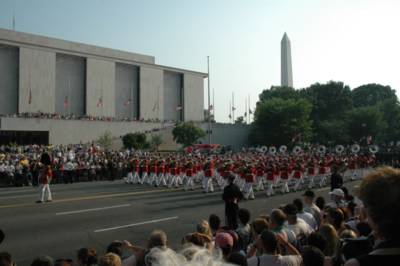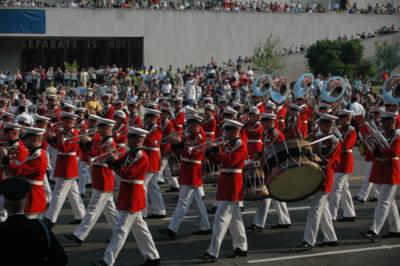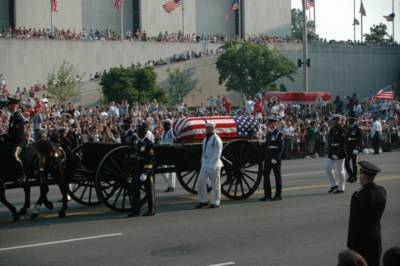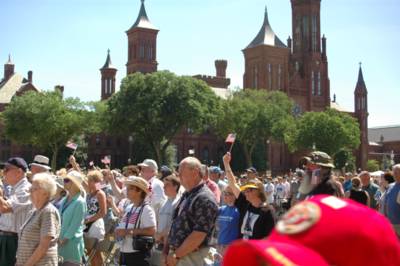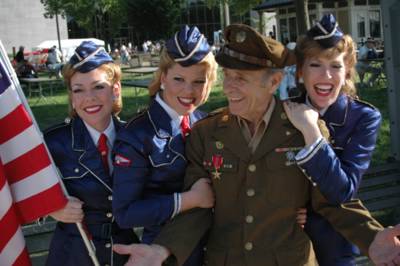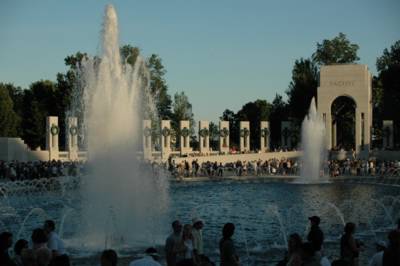Wednesday, June 30, 2004

Boeing 307 Stratoliner "The Flying Cloud"
This airliner was derived from the B-17C bomber and the first pressurized passenger aircraft, which gives it that swollen look. A pressurized cabin allows an airliner to fly above bad weather, allowing for more reliable flight schedules undeterred by thunderstorms.
They only built ten of these babies. One was bought by billionaire Howard Hughes who made it into his "flying penthouse," complete with bedroom, bar, and living room. It ended up as a houseboat in Florida.
This particular plane flew for Pan Am in the Carribean during WWII. Wacky dictator of Haiti "Papa Doc" Duvalier bought it for his personal use but never used it personally, fearing all planes and pilots.
Boeing restored it in Seattle for the Smithsonian over about eight years. During a test flight, it ran out of fuel even though the cockpit fuel guage said there was plenty. The pilot ditched it in Elliot Bay right in front of the startled diners at Salty's Restaurant in West Seattle and a Coast Guard station. The Coast Guard rescued the fliers before the Flying Cloud turned into a submarine. They didn't even get their feet wet.
It took another year to restore it again to flying condition. Usually, once a plane is soaked in saltwater it is taken out of flying service. Saltwater corrodes metal over years and there is no way to wash it out of every nook and cranny. However, this plane only needed to fly cross-country once to Washington.

It cost $12,000 for a one way ticket to ride one of the hundred seats on this Air France Concorde SuperSonic Transport (SST) for a three hour flight across the Atlantic at twice the speed of sound. Way up at 60,000 feet where it flew, the passengers could see the horizon curve. I was surprised to see the passenger windows were about the size of postcards. Tiny little things.
The first Concorde flew back in 1969 while America was landing on the moon. The French and British saw the Concorde as a sort of Apollo Program Lite, showing that they were just as technologically advanced as those damned Americans. Pan Am was the first to order six Concordes, or actually the rights to buy them, at the same time it was taking reservations for passenger flights to the moon. That inspired other airlines to place their orders too.
A total of 120 Concordes were planned to be built until Pan Am sobered up and backed out and all the other airlines chickened out too. That left the state-owned airlines of England and France, who had no choice but to fly them. A total of sixteen were built, two prototypes, seven for British Airways and seven for Air France. The Concorde never made money for France but made a billion pounds profit for the Brits in the 1980s under careful management.
They had one hell of a time getting landing rights in New York where the loony ecology movement warned that the Concorde would tear up the atmosphere, depleting the ozone, and cause massive increases in skin cancer. Of course, nothing of the kind happenned and the ecologists became environmentalists warning us about global warning.
The Concorde took a heavy blow to its reputation when one crashed on takeoff from Paris in 2002, killing 113 people and grounding the fleet for a year. The Concorde fleet was 27 years old. Aircraft usually are built to last twenty years after which maintenance costs start ratcheting up. The Concordes stopped flying in 2003, too expensive to fly.

Mercury Capsule 15B "Freedom 7 II"
Alan Shepherd was supposed to fly this capsule at the tail end of the Mercury program but NASA had already accomplished its objectives and cancelled his flight to press on with the Gemini program. Consequently, this is the only Mercury capsule that still sports the retrorocket package on its backside and the parachute package on its nose.
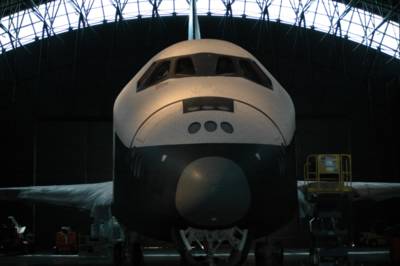
Space Shuttle Enterprise, Orbiter Vehicle 101, was the first shuttle. It never flew in space nor could it. It was used for flight tests in the atmosphere way back in 1977. They lifted it to altitude on the back of the Boeing 747 carrier aircraft and launched it to test its systems for descent and landing. It was the first shuttle built.
When I was a cadet at the Air Force Academy, an instructor in a science course brought in one of the thermal tiles for the shuttle, placed it in a kiln with tongs, and fired it up until it was glowing whitish-orange. By the time he pulled it back out with the tongs and pulled his asbestos gloves off, it had cooled off so that it was darker around the corners but still glowing orange in the center. He reached down and picked it up off the ceramic plate with his bare hand as we gasped and flinched. The tile material just does not retain heat, so the surface cools off very rapidly.

Exiting the museum you see this abstract sculpture that probably is supposed to represent the essence of flight or some such crap. It looks like a stainless steel curly fry to me. For some inexplicable reason, the people who make aeronautical monuments shun heroic human forms in their sculptures in favor of wacked out abstractions that don't mean anything to anyone. I'd much rather see a heroic bronze pilot climbing into the cockpit of a P-51 Mustang.
Monday, June 14, 2004
Reagan's Funeral Procession; June 9, 2004
I hopped on the Metro after work to see Reagan's funeral procession pass down Constitution Avenue. I had a good spot picked out on the stairs of a federal building across from the National Museum of American History, but when I got there it was all roped off. I thought the crowd might take their time getting there but it was already packed an hour before the caisson was due to roll by. It was too crowded to get a good shot from street level so I climbed up on a planter with three other people and stood there for an hour to get a good view.
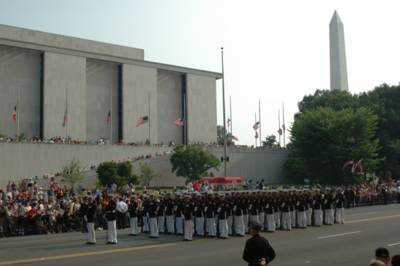
Once all the military units had formed up and marched out to their holding position, nothing much happenned. We watched them change from parade rest to attention and back every ten minutes. They do that so that guys don't pass out in the heat. It was fairly warm. It didn't completely work because I heard an ambulance moving in to pick up some guy far ahead of us who had planted his face in the asphalt.
Sunday, June 13, 2004

Here come the Marines.
Generally, the Marines and the cadets from the military academies marched the best. My completely objective observation is that the Air Force Academy cadets were the sharpest marching troops of them all. The worst were the cadets from the Merchant Marine Academy, all of them out of step, each marching to his own secret drummer. They looked like civilians who had robbed a uniform store and were making their escape.

A local TV reporter was watching the casket being maneuvered into position inside the Capitol on a portable monitor. A quiet crowd gathered to watch.
I jumped on the Metro, which was packed with people but whose air conditioning had failed. It was like a sauna. I got off sopping wet with sweat. It was the most miserable Metro ride I ever had. Nevertheless, it was all worth it to wish the Gipper good-bye.
WWII Memorial Dedication; May 29, 2004
You know I couldn't miss this. I hopped the Metro out to the National Mall and took my pix. It was a nice crowd. It was just interesting as hell to listen to these old vets tell their tales or just hang out with them.

A Navajo code talker gets the rock star treatment from a crowd of admirers begging for his autograph. The Navajos were recruited by the Marines to pass battlefield information over the radio in their native language, which the Japanese had no chance in hell of cracking. It's just incredible to actually see one in person.
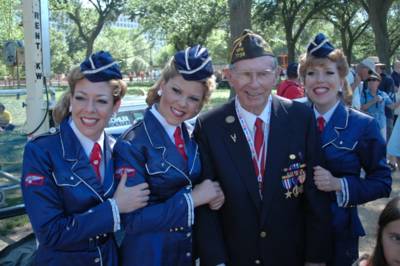
The Liberty Belles are a trio of singers who recall the Andrews Sisters of the 1940s. They spent a good part of the day on the Mall posing in their cute little satin costumes with the vets, who seemed to perk up considerably once they had some cute chicks draped all over them. The Belles sang a stanza or two of "Boogie Woogie Bugle Boy" during some photos and they were pretty damned good. The vets left happy, many of them with a big red lipstick kiss print on their cheek.

This old Sherman tank driver (lower left) lost three tanks in the war, like the Sherman behind him. He lost one in North Africa, two in Europe. He was driving one of twenty-nine tanks in the first waves of the Normandy invasion with a skirt, a new-fangled invention that allowed the tanks to swim to shore, or so they thought. The sea was a little too heavy for that, the waves lapped over the top, and his tank swamped in about five minutes. He had to swim the last couple thousand feet to shore. Only two tanks made it to the beach. They were destroyed immediately. He didn't get another tank for three weeks. He was a happy guy, full of piss and vinegar. He's traded his Sherman for a scooter now. Get the hell out of the way!

The happy crowd was jitterbugging to a boogie woogie beat.
There was a heavy presence of police around the Mall but, unless there were security measures I could not see, the festivities still seemed like an easy target. There were no barriers to a truck bomb driven by some suicidal jihadi speeding into the crowd and detonating himself.
But nothing of the sort happenned. Were we just lucky or were our defenses good enough to preempt attacks? I hope it's the latter.










